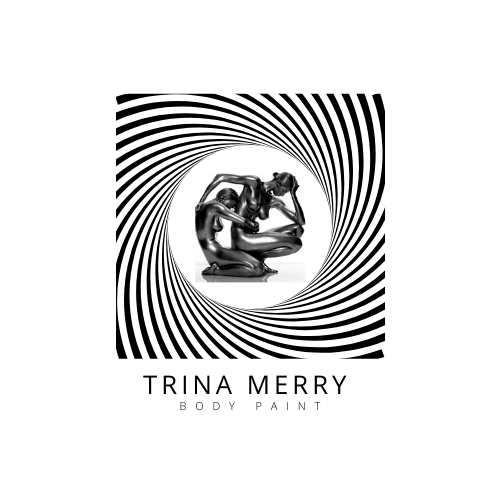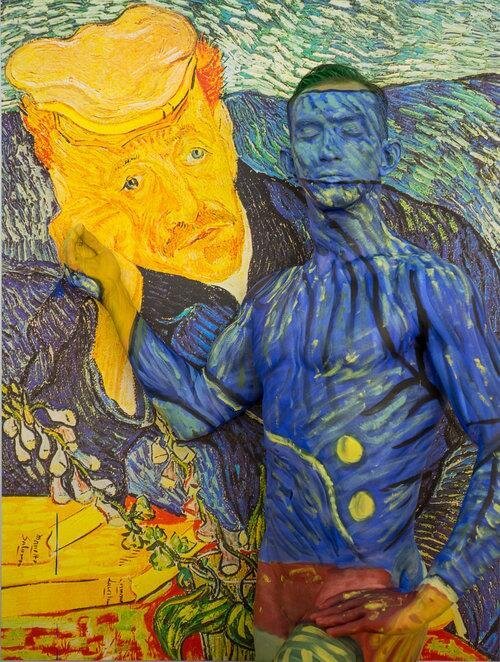"Lust of Currency", a body painting art series by NY Artist Trina Merry
The New York-based artist, 40, re-interpreted over 50 masterpiece paintings by artists including Pablo Picasso, Leonardo da Vinci, Vincent van Gogh, and Jackson Pollock as part of her collection, which questions how art in this modern age is evaluated: historical significance, popularity or price tag? By camouflaging models into the most expensive paintings ever sold, Merry queries the people who are influencing art in this new economy and the role of the artist today. Each painting, which Merry creates using the trompe l'oeil technique, has been renamed by their astronomical selling price.
"I created 'Lust of Currency' as a means to reflect on today's art world, and how our most famous paintings are being used as commodities to be sold, bought or traded by a rarefied audience," said Merry. "Some of our greatest pieces of art are better known by their auction price, which is a telling sign that societal, political and economic forces have greatly impacted our culture.'“ -says Merry.
The controversial da Vinci painting was recently sold for a record-breaking $450.3 million last November during a 19-minute auction held by the auction house Christie's, which marketed the painting as "The Last Da Vinci." The anonymous buyer was later revealed to be Saudi prince Bader bin Abdullah bin Mohammed bin Farhan al-Saud. The first time Merry recreated the painting it was valued at $127.5 million. "It's the only time I've had to change the name of an art piece before," she said.
Artist Statement:
How do we value art? Is it by a work’s historical significance, it’s popularity, or by how much someone is willing to pay for it? This series examines some of the most expensive works of art and are titled by how much, approximately, a collector paid for the work.
During a period of a record Dow Jones high and in an era where the USA has a millionaire president (but the National Endowment for the Arts is being discontinued) how will the art economy change? What will be the new role of the artist? How are auctions, art fairs and the Internet changing the market and the way we see art? We examine who are the people behind this arts economy.
The master paintings for this series were printed out as backdrops, allowing Merry to then camouflage body painted performance artists into the masterpieces and documented with photography. Each painting is titled by their final price tag, though remain fluid as in the example of the recent controversial sale of Leonardo da Vinci's “Salvator Mundi,” which appreciated from "$127.5 million" to "$450.3 million” in a record 19-minute auction when it was purchased by an un-identified Saudi by telephone in November.
“Some of our greatest pieces of art are better known by their auction price, which is a telling sign that societal, political and economic forces have greatly impacted our culture,” said Merry.
View more works HERE
fun facts about the lust of currency series.
It took 30 minutes-3.5 hours to make each bodypainting.
Trina Merry and her team have been working on this series for about one and a half years.
There are 34 total works in this series plus four Warhol “Money” pieces.
This exhibition sold out at Con Artist Gallery last June in only 3 days. Trina has since added 13 new works.
After Trina made da Vinci's "Salvator Mundi”, which she titled “$127,500,000” it resold at auction for a whopping $450,300,000. It’s the first time she’s ever had to change the name of the artwork.
Basquiat’s “Untitled”* sold at auction for $150,000,000 the week of the exhibition so Trina created this piece live at Con Artist Gallery to include it among the top 20 highest priced artworks.
The Tate Modern currently has some the Picasso’s and Modigliani’s on featured exhibitions. Trina saw both exhibitions while in London.
The "$165,000,000 (Lichtenstein)” and "$135,000,000 (Klimt)” were featured at Red Dot Miami with Lemon Frame Gallery. She created “$92,500,000 (Picasso)” live.
“$80,000,000 (Johns)” was filmed by FOX News 5*. Trina did it in about 30 minutes with assistant Katy Rameriez.
“$80,000,000 (Warhol)” was painted by Trina twice- once for video and once in studio. The first one will be making its debut at Superfine! Art Fair.
Trina printed a massive 60x40” framed print of “$78,400,000 (Renoir)” for her dining area.
Trina loved seeing “Loving Vincent” as there were several of his works featured this series
“$71,500,000 (Van Gogh)” and "$94,500,000 (Lichtenstein)” are Trina’s two favorite new works as they have a high level of detail and technical accuracy.
THIS (Pollock) and THIS (Modigliani) were featured by ARTE TV in special documentaries.
“$69,000,000 (Modigliani)” was created live at the performance team’s annual Christmas party. It will also be on exhibition this month in a 24x36” size for “Nude Attitude” in Peoria, Chicago (unaltered stretched canvas print). This image and $94,500,000 (Lichtenstein) are the two most liked images from this series on Trina’s Instagram
Trina Merry is an acclaimed body painter known internationally for camouflaging people into environments and making living sculptures out of multiple bodies, then photographing her creations. Through her work, she has raised the profile of the medium to a fine art as she is exhibited in prestigious galleries, museums and showrooms across the globe, including the Whitney Museum of American Art's Biennial. She discovered the craft unexpectedly – she was struck by lightning while driving in Los Angeles and developed a sensitivity to electricity and power grids. She moved to Yosemite National Park, where she began to body paint, inspired by the work of artists like Yves Klein, Yayoi Kusama, and Verushka. She also studied with acclaimed talents Robert Wilson and Marina Abramovic as a Watermill Center Summer Participant, where she created five living body paint installations on site. She has studied drawing and painting with Alex and Allyson Grey and was a body paint apprentice with Craig Tracy, judge for the TV show "Skin Wars".






















